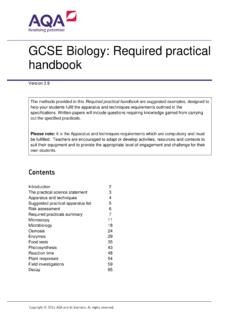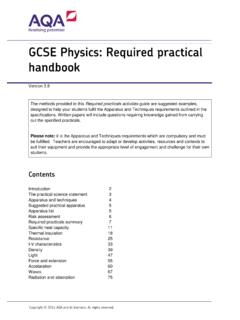Transcription of GCSE Biology: Required practical handbook
1 Copyright 2016 AQA and its licensors. All rights reserved. GCSE Biology: Required practical handbook Version The methods provided in this Required practical handbook are suggested examples, designed to help your students fulfil the apparatus and techniques requirements outlined in the specifications. Written papers will include questions requiring knowledge gained from carrying out the specified practicals. Please note: it is the Apparatus and techniques requirements which are compulsory and must be fulfilled. Teachers are encouraged to adapt or develop activities, resources and contexts to suit their equipment and to provide the appropriate level of engagement and challenge for their own students. Contents Introduction 2 The practical science statement 3 Apparatus and techniques 4 Suggested practical apparatus list 5 Risk assessment 6 Required practicals summary 7 Microscopy 11 Microbiology 18 Osmosis 24 Enzymes 29 Food tests 35 Photosynthesis 43 Reaction time 48 Plant responses 54 Field investigations 59 Decay 65 2 Copyright 2016 AQA and its licensors.
2 All rights reserved. Introduction Students need to undertake the Required practical activities listed in the GCSE Biology specification (8461) so that they have the opportunity to experience all of the apparatus and techniques Required by Ofqual. In this guide, we suggest methods and activities for carrying out the Required practical activities to help you plan the best experience for your students. All of the activities we describe have been written and trialled by practising teachers and use apparatus and materials that are commonly available in most schools. Why do practical work? practical work is at the heart of science that s why we have placed it at the heart of each of our GCSE science specifications. There are three separate, but interconnected, reasons for doing practical work in schools. 1. To support and consolidate scientific concepts. Doing practical work enables students to make sense of new information and observations, and provides them with insights into the development of scientific thinking.
3 2. To develop investigative skills. These transferable skills include: devising and investigating testable questions identifying and controlling variables analysing, interpreting and evaluating data. 3. To build and master practical skills such as: using specialist equipment to take measurements handling and manipulating equipment with confidence and fluency recognising hazards and planning how to minimise risk. This guide signposts opportunities for developing these working scientifically skills (WS). Working scientifically is explained in more detail in the GCSE Biology specification on page 9. 3 Copyright 2016 AQA and its licensors. All rights reserved. Helping you to plan This guide includes: teachers notes providing information and tips on setting up and running practicals technical information providing guidance for technicians preparing for the practicals student sheets providing a possible method for students to carry out the practical .
4 The student sheets contain a blank space for students to add the learning outcomes. By focusing on the reasons for carrying out a particular practical , you will help your students to: understand the subject better develop the skills of a scientist master the manipulative skills Required for further study or jobs in STEM subjects. At least 15% of the marks in the written exams will draw on the knowledge and understanding students have gained by carrying out the Required practical activities. It is therefore essential that you plan your practical activities with reference to the specification and make students aware of the key content that they need to learn. You can find examples of the type of practical questions students can expect in our guide, Practicals in exams. We have designed the methods in this guide specifically to help your students fulfil the Apparatus and techniques requirements outlined in the specification. We encourage you to adapt or develop these activities, resources and contexts to suit your circumstances and to tailor the level of engagement and challenge to your students.
5 To help you do this, we ve provided the guide in Word. The practical science statement Unlike the A-levels, there will be no practical endorsement. Instead, we will provide the head of each school or college with a practical science statement to sign, confirming that reasonable steps have been taken to ensure that each student has: completed the Required practical activities detailed in the specification made a contemporaneous record of such work done during the activities and the knowledge, skills and understanding derived from those activities. 4 Copyright 2016 AQA and its licensors. All rights reserved. The head of centre will need to return the signed statement to us by the date we will publish on our website, on our practicals page. We will also contact schools and colleges directly with the deadline date and send timely reminders if we don t receive the form. Failure to send this form counts as malpractice/maladministration, and may result in formal action or a warning for the school or college.
6 Not having done some of the practicals, despite the school s best efforts, will not stop a student from entering for the GCSE. However, it may affect their grade, because there may be questions in the exams that they won t be able to answer. Apparatus and techniques The following table lists the biology Apparatus and techniques (AT). Students must be given the opportunity to experience all of these during their GCSE Biology course, regardless of the awarding body specification they study. The list includes opportunities for choice and use of appropriate laboratory apparatus for a variety of experimental problem-solving and/or enquiry-based activities. Use and production of appropriate scientific diagrams to set up and record apparatus and procedures used in practical work is common to all science subjects and should be included wherever appropriate. AT 1 7 are common with both of our GCSE Combined Science specifications. AT 8 is for GCSE Biology only.
7 Where possible, we have added links to the Apparatus and techniques in our A-level Biology course, to show how the skills progress from GCSE to A-level. Apparatus and techniques AT 1 Use of appropriate apparatus to make and record a range of measurements accurately, including length, area, mass, time, temperature, volume of liquids and gases, and pH (links to A-level AT a). AT 2 Safe use of appropriate heating devices and techniques including use of a Bunsen burner and a water bath or electric heater (links to A-level AT a). AT 3 Use of appropriate apparatus and techniques for the observation and measurement of biological changes and/or processes. AT 4 Safe and ethical use of living organisms (plants or animals) to measure physiological functions and responses to the environment (links to A-level AT h). AT 5 Measurement of rates of reaction by a variety of methods including production of gas, uptake of water and colour change of indicator. 5 Copyright 2016 AQA and its licensors.
8 All rights reserved. AT 6 Application of appropriate sampling techniques to investigate the distribution and abundance of organisms in an ecosystem via direct use in the field (links to A-level AT k). AT 7 Use of appropriate apparatus, techniques and magnification, including microscopes, to make observations of biological specimens and produce labelled scientific drawings (links to A-level AT d and e). AT 8 Use of appropriate techniques and qualitative reagents to identify biological molecules and processes in more complex and problem-solving contexts including continuous sampling in an investigation (links to A-level AT f). Suggested practical apparatus list Through their study of the new GCSE sciences students must be given the opportunity to experience a wide range of apparatus. Hands-on experience will help them acquire the practical skills defined by the DfE in their Apparatus and techniques criteria. We have designed all the activities to use standard equipment and materials that can be found in most school laboratories.
9 The lists are not exhaustive, and we encourage teachers to modify the activities to suit their students needs and learning objectives, and the resources available in their school/college. Lab equipment m2 quadrats 10 cm3 plastic syringes 10 cm3 measuring cylinders 100 cm3 conical flasks 250 cm3 beakers 30 cm rulers 30 m tape measures 5 cm3 measuring cylinders/syringes boiling tubes Bunsen burners cork borer digital top pan balances (accurate to ) disposable plastic pipettes dropping bottles filter funnels and filter paper filter paper discs forceps gauze mats glass stirring rods glass spreaders heatproof mats incubator 6 Copyright 2016 AQA and its licensors. All rights reserved. light sources (LED or standard. Not energy saving) metre rulers microscope slide coverslips microscope slides microscopes pestles and mortars petri dishes Perspex rulers spotting tiles stopwatches test tube racks test tubes thermometers (stirring) tripods water baths (electrical or Bunsen burners and beakers) wax pencils white tiles Specialist supplies 1% VirKon disinfectant amylase solution Benedict s solution biuret solution buffered solution culture of E.
10 Coli bacteria (K12 or B strain) distilled water ethanol iodine solution lipase solution (5%) nutrient agar plates Cresol red pond weed (Elodea or Cabomba are recommended) sodium carbonate solution ( M) sodium hydrogen carbonate solution ( ) starch solution Sudan III stain solution white mustard seeds Risk assessment Safety is an overriding requirement for all practical work. Although all of the suggested practical activities have been suggested by teachers who have successfully carried them out in the lab, schools and colleges are responsible for ensuring that appropriate safety procedures are followed whenever their students undertake practical work, and should undertake full risk assessments. 7 Copyright 2016 AQA and its licensors. All rights reserved. Required practicals summary The practicals that have been selected will be familiar, using apparatus and materials that are readily available in most schools. This table summarises the ten practicals Required for Biology GCSE.




